Communication, Organization and Innovation: A Detailed Report
VerifiedAdded on 2020/02/24
|8
|1347
|56
Report
AI Summary
This report provides an analysis of communication, organization, and innovation. It begins by defining communication events and their significance, followed by a discussion on verbal and non-verbal communication, including kinesics, facial expressions, haptics, paralanguage, and proxemics. The report then explores various communication theories, highlighting their importance in understanding how messages are transferred. Organizational communication is examined, emphasizing its role in achieving business goals and the importance of effective communicators. The report also includes a conclusion and references, providing a comprehensive overview of the subject matter.
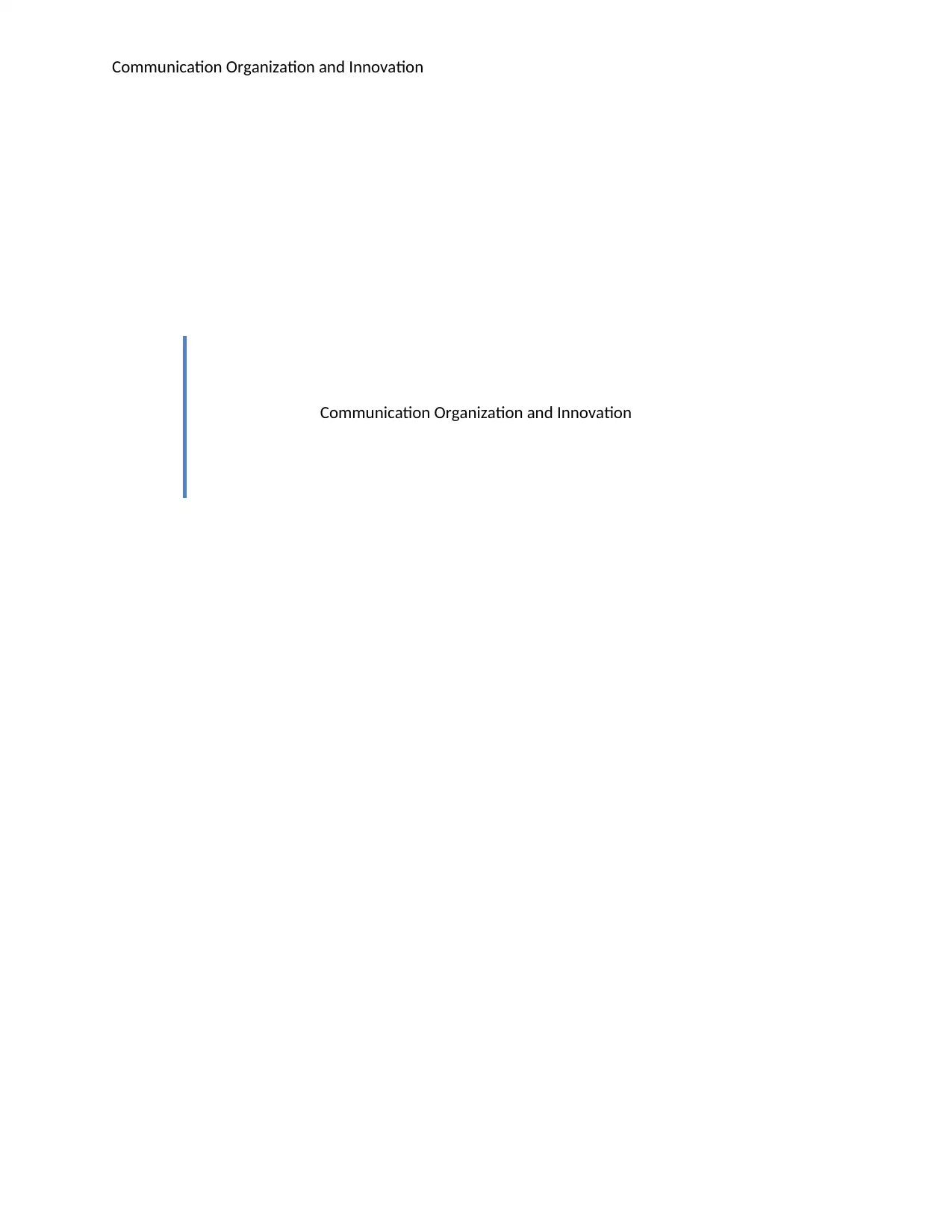
Communication Organization and Innovation
Communication Organization and Innovation
Communication Organization and Innovation
Paraphrase This Document
Need a fresh take? Get an instant paraphrase of this document with our AI Paraphraser
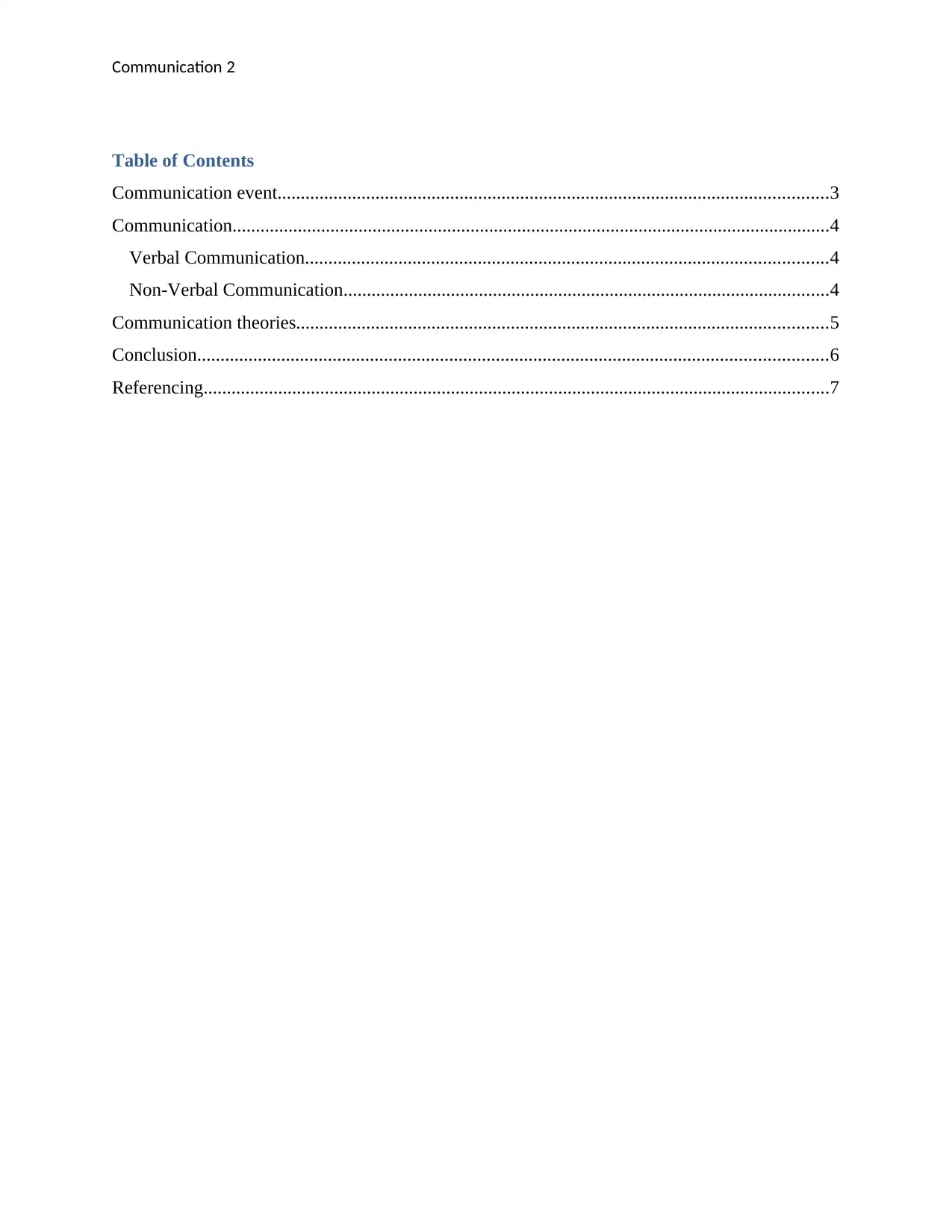
Communication 2
Table of Contents
Communication event......................................................................................................................3
Communication................................................................................................................................4
Verbal Communication................................................................................................................4
Non-Verbal Communication........................................................................................................4
Communication theories..................................................................................................................5
Conclusion.......................................................................................................................................6
Referencing......................................................................................................................................7
Table of Contents
Communication event......................................................................................................................3
Communication................................................................................................................................4
Verbal Communication................................................................................................................4
Non-Verbal Communication........................................................................................................4
Communication theories..................................................................................................................5
Conclusion.......................................................................................................................................6
Referencing......................................................................................................................................7
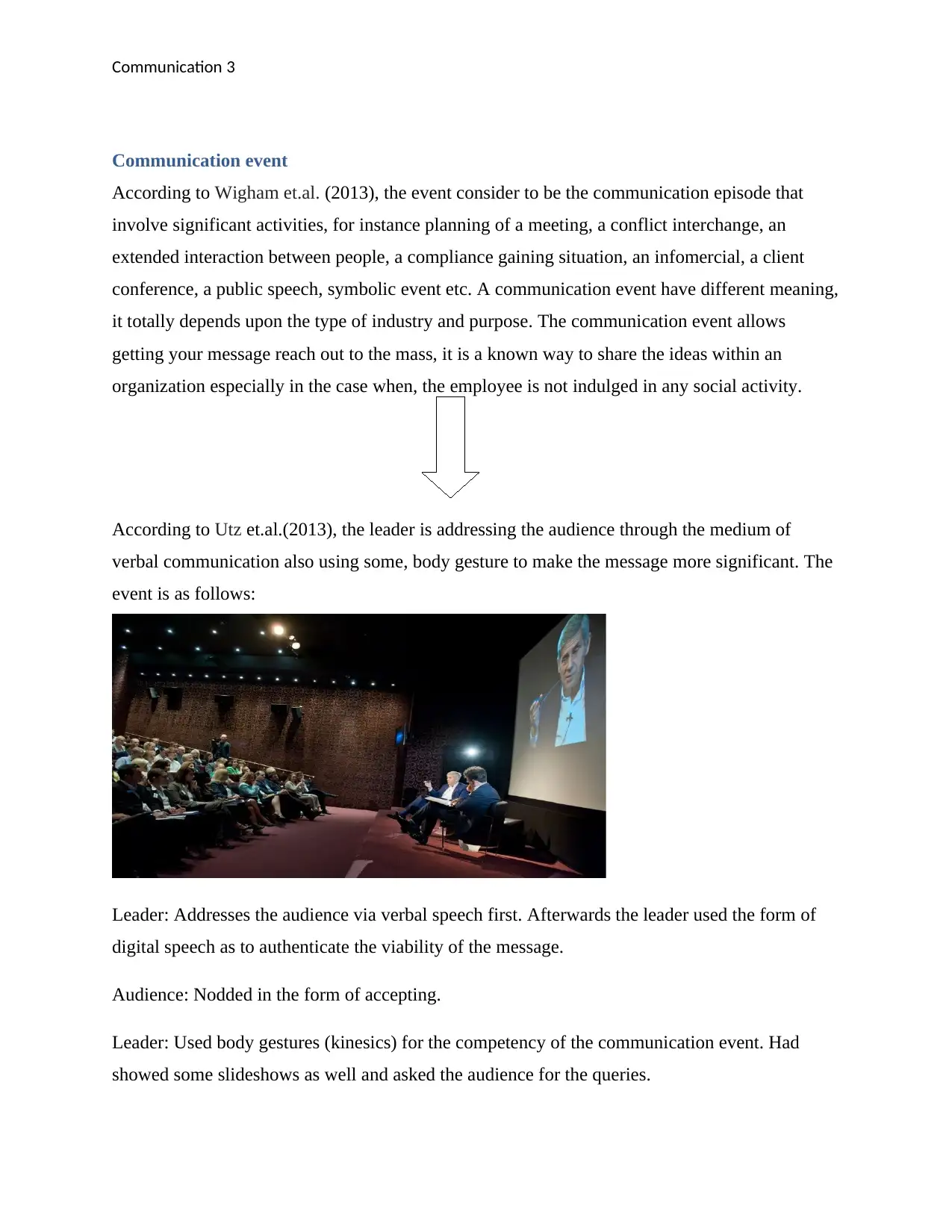
Communication 3
Communication event
According to Wigham et.al. (2013), the event consider to be the communication episode that
involve significant activities, for instance planning of a meeting, a conflict interchange, an
extended interaction between people, a compliance gaining situation, an infomercial, a client
conference, a public speech, symbolic event etc. A communication event have different meaning,
it totally depends upon the type of industry and purpose. The communication event allows
getting your message reach out to the mass, it is a known way to share the ideas within an
organization especially in the case when, the employee is not indulged in any social activity.
According to Utz et.al.(2013), the leader is addressing the audience through the medium of
verbal communication also using some, body gesture to make the message more significant. The
event is as follows:
Leader: Addresses the audience via verbal speech first. Afterwards the leader used the form of
digital speech as to authenticate the viability of the message.
Audience: Nodded in the form of accepting.
Leader: Used body gestures (kinesics) for the competency of the communication event. Had
showed some slideshows as well and asked the audience for the queries.
Communication event
According to Wigham et.al. (2013), the event consider to be the communication episode that
involve significant activities, for instance planning of a meeting, a conflict interchange, an
extended interaction between people, a compliance gaining situation, an infomercial, a client
conference, a public speech, symbolic event etc. A communication event have different meaning,
it totally depends upon the type of industry and purpose. The communication event allows
getting your message reach out to the mass, it is a known way to share the ideas within an
organization especially in the case when, the employee is not indulged in any social activity.
According to Utz et.al.(2013), the leader is addressing the audience through the medium of
verbal communication also using some, body gesture to make the message more significant. The
event is as follows:
Leader: Addresses the audience via verbal speech first. Afterwards the leader used the form of
digital speech as to authenticate the viability of the message.
Audience: Nodded in the form of accepting.
Leader: Used body gestures (kinesics) for the competency of the communication event. Had
showed some slideshows as well and asked the audience for the queries.
⊘ This is a preview!⊘
Do you want full access?
Subscribe today to unlock all pages.

Trusted by 1+ million students worldwide
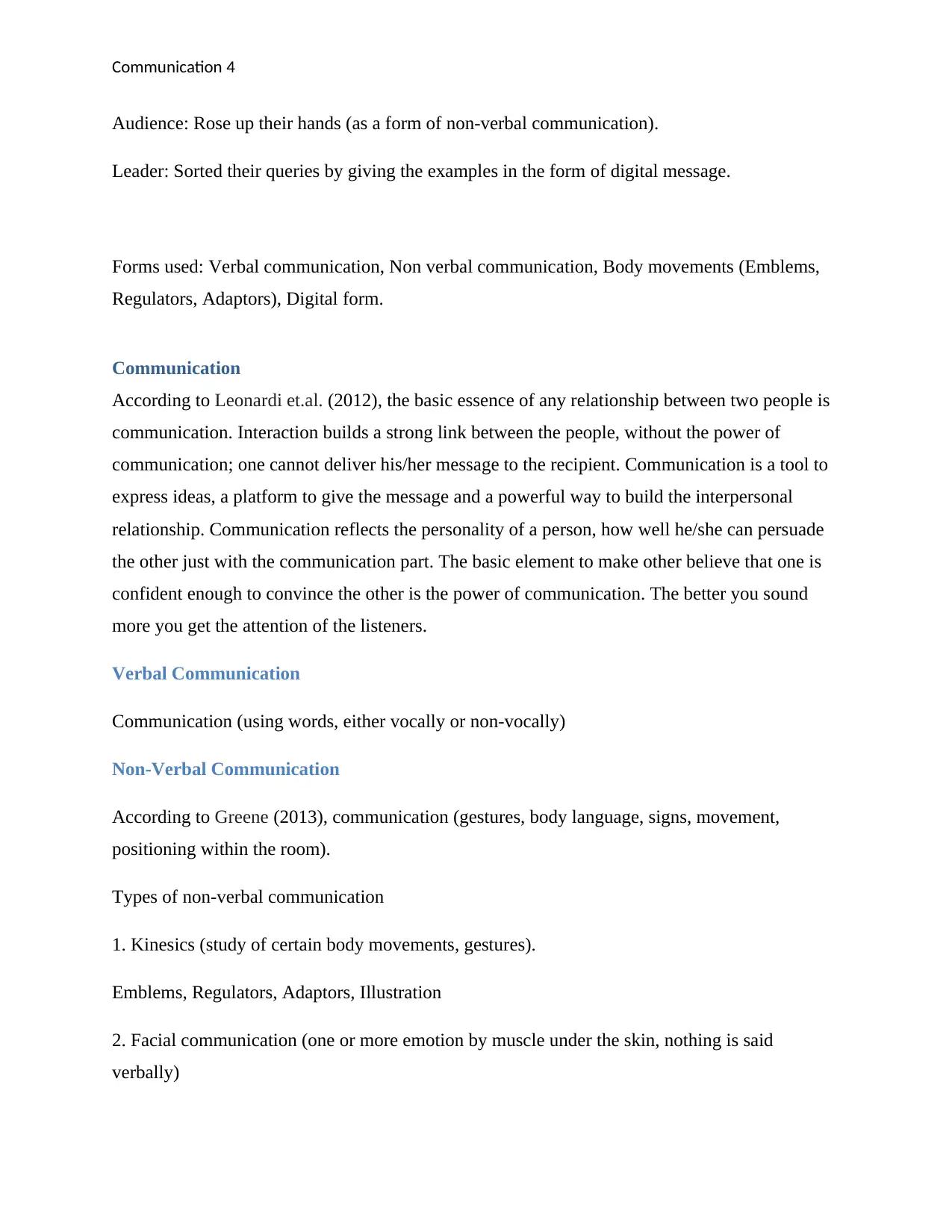
Communication 4
Audience: Rose up their hands (as a form of non-verbal communication).
Leader: Sorted their queries by giving the examples in the form of digital message.
Forms used: Verbal communication, Non verbal communication, Body movements (Emblems,
Regulators, Adaptors), Digital form.
Communication
According to Leonardi et.al. (2012), the basic essence of any relationship between two people is
communication. Interaction builds a strong link between the people, without the power of
communication; one cannot deliver his/her message to the recipient. Communication is a tool to
express ideas, a platform to give the message and a powerful way to build the interpersonal
relationship. Communication reflects the personality of a person, how well he/she can persuade
the other just with the communication part. The basic element to make other believe that one is
confident enough to convince the other is the power of communication. The better you sound
more you get the attention of the listeners.
Verbal Communication
Communication (using words, either vocally or non-vocally)
Non-Verbal Communication
According to Greene (2013), communication (gestures, body language, signs, movement,
positioning within the room).
Types of non-verbal communication
1. Kinesics (study of certain body movements, gestures).
Emblems, Regulators, Adaptors, Illustration
2. Facial communication (one or more emotion by muscle under the skin, nothing is said
verbally)
Audience: Rose up their hands (as a form of non-verbal communication).
Leader: Sorted their queries by giving the examples in the form of digital message.
Forms used: Verbal communication, Non verbal communication, Body movements (Emblems,
Regulators, Adaptors), Digital form.
Communication
According to Leonardi et.al. (2012), the basic essence of any relationship between two people is
communication. Interaction builds a strong link between the people, without the power of
communication; one cannot deliver his/her message to the recipient. Communication is a tool to
express ideas, a platform to give the message and a powerful way to build the interpersonal
relationship. Communication reflects the personality of a person, how well he/she can persuade
the other just with the communication part. The basic element to make other believe that one is
confident enough to convince the other is the power of communication. The better you sound
more you get the attention of the listeners.
Verbal Communication
Communication (using words, either vocally or non-vocally)
Non-Verbal Communication
According to Greene (2013), communication (gestures, body language, signs, movement,
positioning within the room).
Types of non-verbal communication
1. Kinesics (study of certain body movements, gestures).
Emblems, Regulators, Adaptors, Illustration
2. Facial communication (one or more emotion by muscle under the skin, nothing is said
verbally)
Paraphrase This Document
Need a fresh take? Get an instant paraphrase of this document with our AI Paraphraser
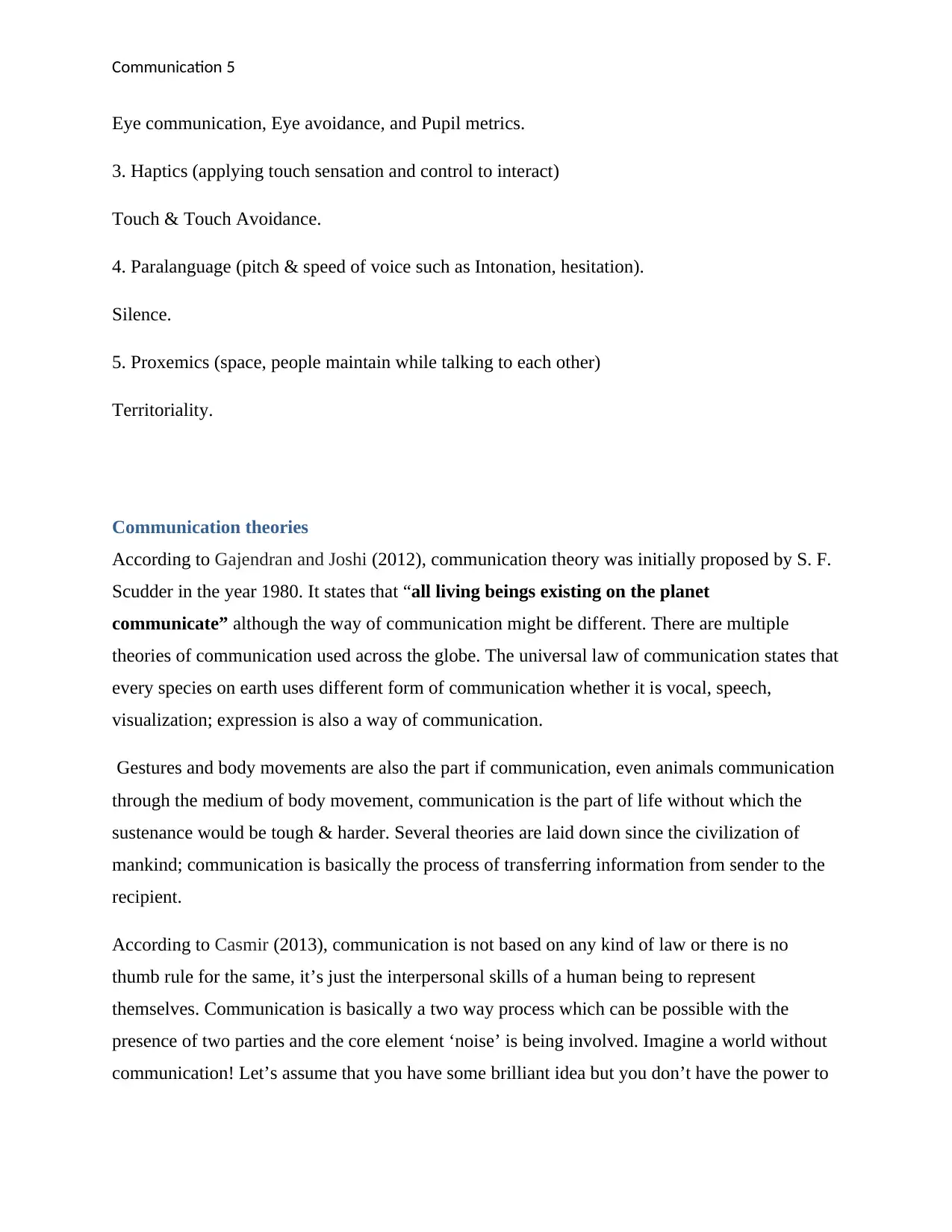
Communication 5
Eye communication, Eye avoidance, and Pupil metrics.
3. Haptics (applying touch sensation and control to interact)
Touch & Touch Avoidance.
4. Paralanguage (pitch & speed of voice such as Intonation, hesitation).
Silence.
5. Proxemics (space, people maintain while talking to each other)
Territoriality.
Communication theories
According to Gajendran and Joshi (2012), communication theory was initially proposed by S. F.
Scudder in the year 1980. It states that “all living beings existing on the planet
communicate” although the way of communication might be different. There are multiple
theories of communication used across the globe. The universal law of communication states that
every species on earth uses different form of communication whether it is vocal, speech,
visualization; expression is also a way of communication.
Gestures and body movements are also the part if communication, even animals communication
through the medium of body movement, communication is the part of life without which the
sustenance would be tough & harder. Several theories are laid down since the civilization of
mankind; communication is basically the process of transferring information from sender to the
recipient.
According to Casmir (2013), communication is not based on any kind of law or there is no
thumb rule for the same, it’s just the interpersonal skills of a human being to represent
themselves. Communication is basically a two way process which can be possible with the
presence of two parties and the core element ‘noise’ is being involved. Imagine a world without
communication! Let’s assume that you have some brilliant idea but you don’t have the power to
Eye communication, Eye avoidance, and Pupil metrics.
3. Haptics (applying touch sensation and control to interact)
Touch & Touch Avoidance.
4. Paralanguage (pitch & speed of voice such as Intonation, hesitation).
Silence.
5. Proxemics (space, people maintain while talking to each other)
Territoriality.
Communication theories
According to Gajendran and Joshi (2012), communication theory was initially proposed by S. F.
Scudder in the year 1980. It states that “all living beings existing on the planet
communicate” although the way of communication might be different. There are multiple
theories of communication used across the globe. The universal law of communication states that
every species on earth uses different form of communication whether it is vocal, speech,
visualization; expression is also a way of communication.
Gestures and body movements are also the part if communication, even animals communication
through the medium of body movement, communication is the part of life without which the
sustenance would be tough & harder. Several theories are laid down since the civilization of
mankind; communication is basically the process of transferring information from sender to the
recipient.
According to Casmir (2013), communication is not based on any kind of law or there is no
thumb rule for the same, it’s just the interpersonal skills of a human being to represent
themselves. Communication is basically a two way process which can be possible with the
presence of two parties and the core element ‘noise’ is being involved. Imagine a world without
communication! Let’s assume that you have some brilliant idea but you don’t have the power to
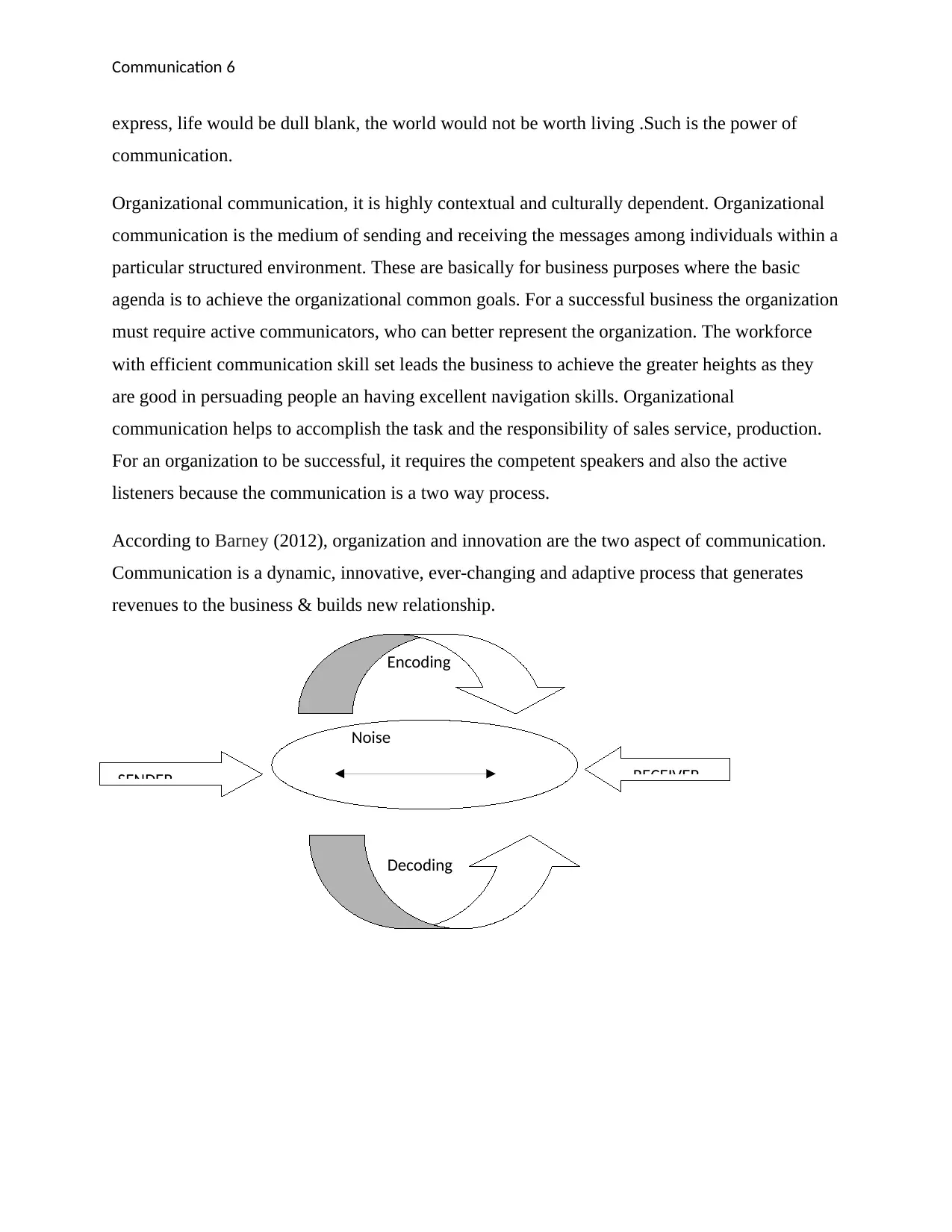
Communication 6
express, life would be dull blank, the world would not be worth living .Such is the power of
communication.
Organizational communication, it is highly contextual and culturally dependent. Organizational
communication is the medium of sending and receiving the messages among individuals within a
particular structured environment. These are basically for business purposes where the basic
agenda is to achieve the organizational common goals. For a successful business the organization
must require active communicators, who can better represent the organization. The workforce
with efficient communication skill set leads the business to achieve the greater heights as they
are good in persuading people an having excellent navigation skills. Organizational
communication helps to accomplish the task and the responsibility of sales service, production.
For an organization to be successful, it requires the competent speakers and also the active
listeners because the communication is a two way process.
According to Barney (2012), organization and innovation are the two aspect of communication.
Communication is a dynamic, innovative, ever-changing and adaptive process that generates
revenues to the business & builds new relationship.
Noise
SENDER RECEIVER
Encoding
Decoding
express, life would be dull blank, the world would not be worth living .Such is the power of
communication.
Organizational communication, it is highly contextual and culturally dependent. Organizational
communication is the medium of sending and receiving the messages among individuals within a
particular structured environment. These are basically for business purposes where the basic
agenda is to achieve the organizational common goals. For a successful business the organization
must require active communicators, who can better represent the organization. The workforce
with efficient communication skill set leads the business to achieve the greater heights as they
are good in persuading people an having excellent navigation skills. Organizational
communication helps to accomplish the task and the responsibility of sales service, production.
For an organization to be successful, it requires the competent speakers and also the active
listeners because the communication is a two way process.
According to Barney (2012), organization and innovation are the two aspect of communication.
Communication is a dynamic, innovative, ever-changing and adaptive process that generates
revenues to the business & builds new relationship.
Noise
SENDER RECEIVER
Encoding
Decoding
⊘ This is a preview!⊘
Do you want full access?
Subscribe today to unlock all pages.

Trusted by 1+ million students worldwide
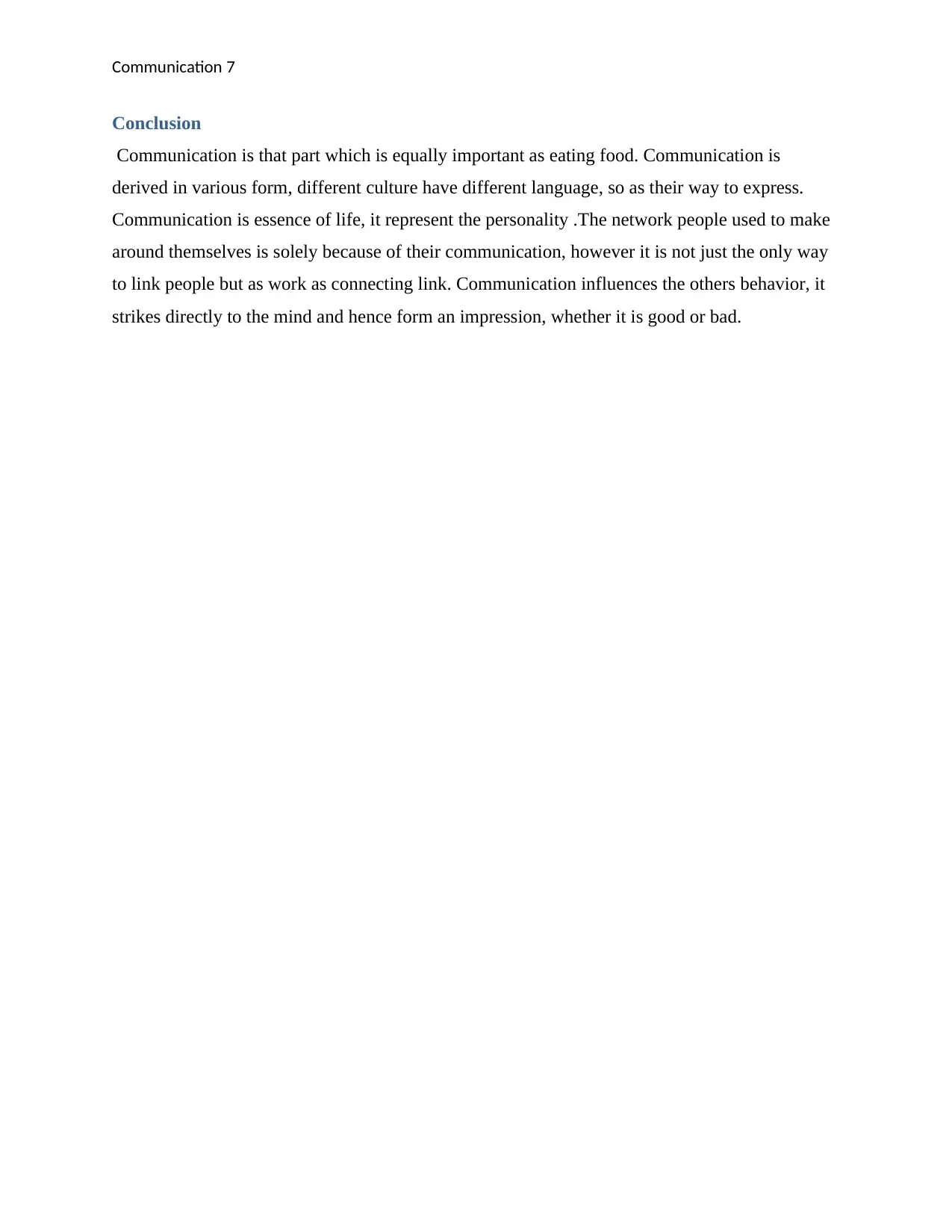
Communication 7
Conclusion
Communication is that part which is equally important as eating food. Communication is
derived in various form, different culture have different language, so as their way to express.
Communication is essence of life, it represent the personality .The network people used to make
around themselves is solely because of their communication, however it is not just the only way
to link people but as work as connecting link. Communication influences the others behavior, it
strikes directly to the mind and hence form an impression, whether it is good or bad.
Conclusion
Communication is that part which is equally important as eating food. Communication is
derived in various form, different culture have different language, so as their way to express.
Communication is essence of life, it represent the personality .The network people used to make
around themselves is solely because of their communication, however it is not just the only way
to link people but as work as connecting link. Communication influences the others behavior, it
strikes directly to the mind and hence form an impression, whether it is good or bad.
Paraphrase This Document
Need a fresh take? Get an instant paraphrase of this document with our AI Paraphraser
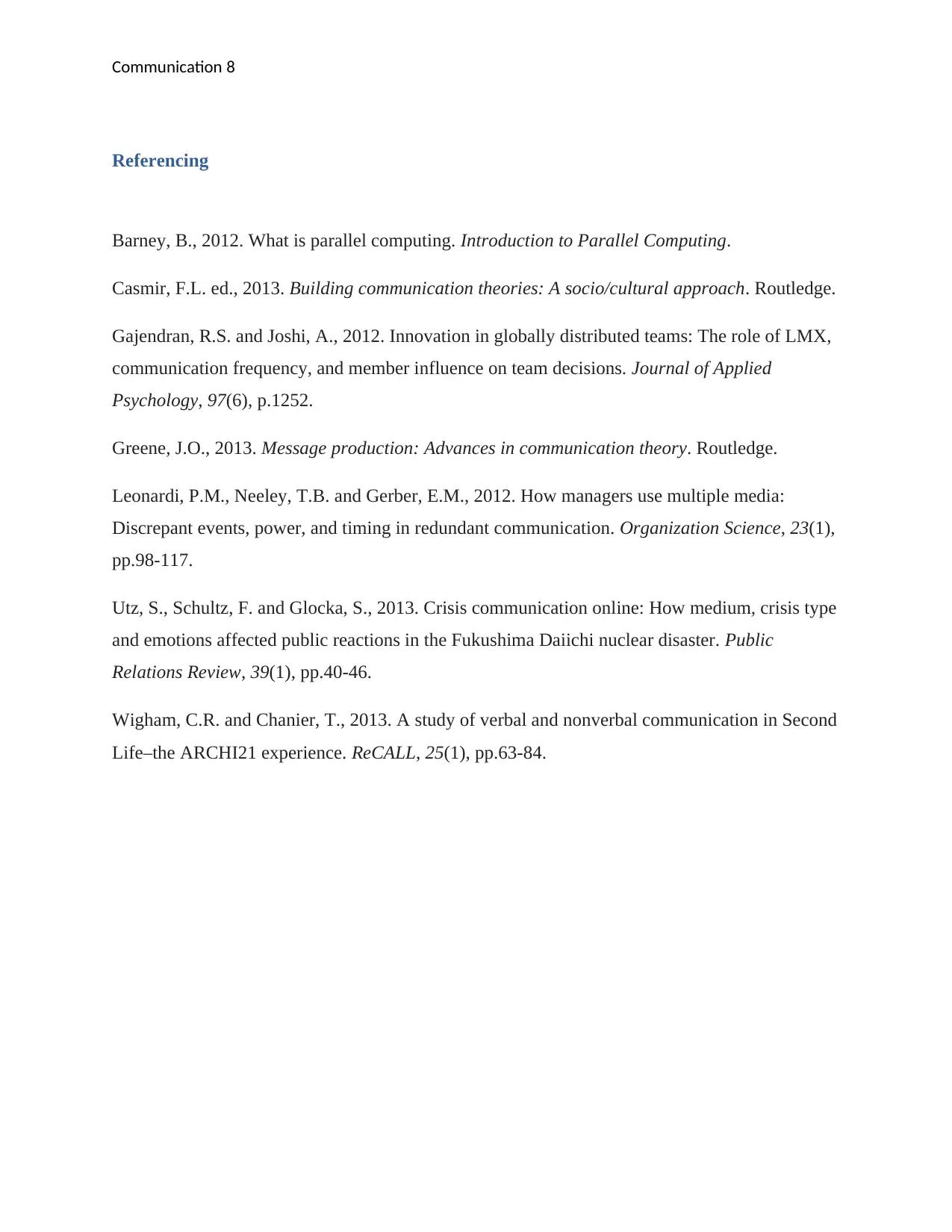
Communication 8
Referencing
Barney, B., 2012. What is parallel computing. Introduction to Parallel Computing.
Casmir, F.L. ed., 2013. Building communication theories: A socio/cultural approach. Routledge.
Gajendran, R.S. and Joshi, A., 2012. Innovation in globally distributed teams: The role of LMX,
communication frequency, and member influence on team decisions. Journal of Applied
Psychology, 97(6), p.1252.
Greene, J.O., 2013. Message production: Advances in communication theory. Routledge.
Leonardi, P.M., Neeley, T.B. and Gerber, E.M., 2012. How managers use multiple media:
Discrepant events, power, and timing in redundant communication. Organization Science, 23(1),
pp.98-117.
Utz, S., Schultz, F. and Glocka, S., 2013. Crisis communication online: How medium, crisis type
and emotions affected public reactions in the Fukushima Daiichi nuclear disaster. Public
Relations Review, 39(1), pp.40-46.
Wigham, C.R. and Chanier, T., 2013. A study of verbal and nonverbal communication in Second
Life–the ARCHI21 experience. ReCALL, 25(1), pp.63-84.
Referencing
Barney, B., 2012. What is parallel computing. Introduction to Parallel Computing.
Casmir, F.L. ed., 2013. Building communication theories: A socio/cultural approach. Routledge.
Gajendran, R.S. and Joshi, A., 2012. Innovation in globally distributed teams: The role of LMX,
communication frequency, and member influence on team decisions. Journal of Applied
Psychology, 97(6), p.1252.
Greene, J.O., 2013. Message production: Advances in communication theory. Routledge.
Leonardi, P.M., Neeley, T.B. and Gerber, E.M., 2012. How managers use multiple media:
Discrepant events, power, and timing in redundant communication. Organization Science, 23(1),
pp.98-117.
Utz, S., Schultz, F. and Glocka, S., 2013. Crisis communication online: How medium, crisis type
and emotions affected public reactions in the Fukushima Daiichi nuclear disaster. Public
Relations Review, 39(1), pp.40-46.
Wigham, C.R. and Chanier, T., 2013. A study of verbal and nonverbal communication in Second
Life–the ARCHI21 experience. ReCALL, 25(1), pp.63-84.
1 out of 8
Related Documents
Your All-in-One AI-Powered Toolkit for Academic Success.
+13062052269
info@desklib.com
Available 24*7 on WhatsApp / Email
![[object Object]](/_next/static/media/star-bottom.7253800d.svg)
Unlock your academic potential
Copyright © 2020–2025 A2Z Services. All Rights Reserved. Developed and managed by ZUCOL.





